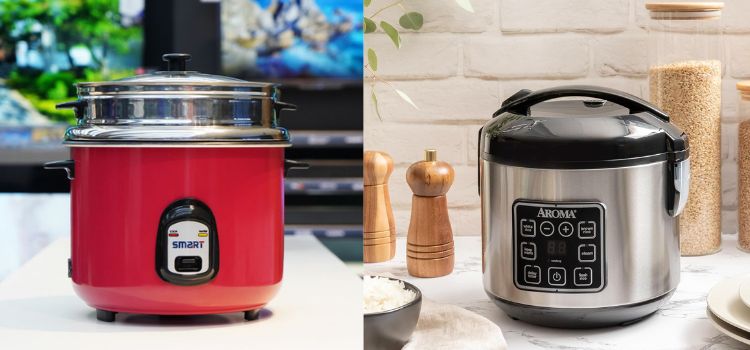As an Amazon Associate, I earn from qualifying purchases

In today’s energy-conscious world, understanding the power consumption of household appliances has become increasingly important. Not only does it help in managing electricity bills, but it also plays a crucial role in fostering environmental sustainability. Among the myriad appliances in modern kitchens, rice cookers have become a staple due to their convenience and efficiency. But how much energy do these handy devices really consume?
Typical Wattage Range for Rice Cookers
Rice cookers come in various models and sizes, each with its own power requirements. Typically, rice cookers operate within a wattage range of 300 to 1200 watts. The wattage depends largely on the size of the cooker and the features it offers. Smaller, basic models usually consume less power, around 300 to 500 watts, as they are intended for smaller quantities of rice. In contrast, larger rice cookers with advanced features like steaming baskets, warming functions, and digital displays may consume up to 1200 watts.
It’s essential to compare wattage across different brands and models to find a rice cooker that matches your needs without overconsuming power. For instance, if you’re cooking for a large family or frequently hosting gatherings, opting for a larger model might be necessary. However, be mindful of the extra energy it might require.
Factors Affecting Energy Usage
Several factors can influence how much energy a rice cooker consumes. Firstly, the size of the cooker is a primary determinant. Larger cookers naturally use more power to heat a greater volume of rice. Additionally, the cooking duration can impact energy consumption. A cooker that takes longer to prepare rice will use more electricity compared to a quicker model.
Moreover, newer rice cookers come with various features designed to enhance cooking efficiency. While these features, such as keep-warm settings or steaming options, increase versatility, they also contribute to higher energy usage. User habits also play a role; frequently using the warming function or cooking small portions in a large cooker can unnecessarily inflate energy consumption.
How to Calculate Energy Costs
Understanding how much your rice cooker adds to your electricity bill involves calculating its energy consumption in kilowatt-hours (kWh). Here’s a simple guide to help you:
- Determine the Wattage: Find the wattage of your rice cooker, which is usually indicated on the appliance or in the user manual.
- Estimate Usage Time: Calculate the average time you use the cooker per day.
- Convert to Kilowatt-Hours: Multiply the wattage by the daily usage time (in hours) and divide by 1,000. This gives you the daily kWh.
- Calculate Cost: Multiply the daily kWh by your electricity rate to estimate your daily cost. For a monthly estimate, multiply this figure by 30.
For example, if your rice cooker uses 600 watts and you run it for 30 minutes per day, it consumes 0.3 kWh daily. At an electricity rate of $0.13 per kWh, this equates to roughly $1.17 per month.
Tips for Choosing an Energy-Efficient Rice Cooker

When shopping for a rice cooker, look for models that prioritize energy efficiency. Here are some features to consider:
- Automatic Shut-Off: This function prevents the cooker from using energy once the rice is done, reducing unnecessary power consumption.
- Insulation: Models with good insulation retain heat better, meaning they require less energy to keep rice warm.
- Energy Star Rating: Consider choosing rice cookers with energy-efficient ratings, which ensure they meet particular energy-saving standards.
- Size Appropriateness: Select a cooker size that matches your needs. A smaller cooker is often more energy-efficient for individuals or small families.
Environmental Impact of Energy Consumption
The energy consumption of household appliances extends beyond financial implications; it also affects the environment. High energy consumption contributes to increased carbon emissions, which in turn exacerbate climate change issues. By reducing energy usage, we can collectively contribute to a more sustainable environment.
Choosing energy-efficient appliances is a simple yet effective way of minimizing your carbon footprint. By understanding the energy consumption of devices like rice cookers, consumers can make informed purchasing decisions that support sustainability.
Conclusion
In conclusion, understanding the wattage and energy consumption of rice cookers is vital for both cost savings and environmental responsibility. With typical wattage ranging from 300 to 1200 watts, various factors like size, features, and user habits can influence energy usage. By calculating the energy costs, consumers can better manage their electricity expenses.
Selecting an energy-efficient rice cooker involves considering features such as automatic shut-off, insulation, and size appropriateness. Additionally, being mindful of the environmental impact of energy consumption encourages more sustainable living choices.
By incorporating these insights, consumers can enjoy the convenience of rice cookers while making conscious efforts to save energy and protect the environment. Whether you’re a student living alone or a parent cooking for a family, understanding and optimizing appliance energy consumption can lead to both financial savings and a healthier planet.
FAQ
Are rice cookers energy efficient?
Yes, rice cookers are generally energy efficient, particularly models with modern features like automatic shut-off and insulation. They use less energy than stovetop cooking by maintaining consistent temperatures and reducing cooking time. Opting for energy-efficient models can further enhance their power-saving benefits.
How many watts is a 10 cup rice cooker?
A 10-cup rice cooker typically uses between 500 to 800 watts. The exact wattage depends on additional features and brand specifications. Larger capacity and multifunctional models may have higher wattage, so it’s important to check the product details for precise energy consumption figures.
Does a rice cooker use a lot of power?
Rice cookers do not use a lot of power compared to other kitchen appliances. They are designed to be efficient, with most models using between 300 to 1200 watts. The power usage varies based on size and features, but overall, they are economical for regular use.
As an Amazon Associate, I earn from qualifying purchases